I met Joyce J. Scott (NA 2018) for the first time at the ceremony and party where she became a National Academician. My first thought, to put it mildly, was that Ms. Scott is what would happen if a supernova decided to take human form. She is a person with a luminous, playful, and penetrative intellect, who also possesses a singular, dazzling, and at times mystifying, wit. She can have you blushing at an outlandish thing she said; seconds later, you may be marveling at a profound statement she made reflecting a sophisticated understanding of some issue or another in the world.
Scott is an educator and artist committed to every possible extension of her creativity. Her oeuvre is comprised of performance, printmaking, jewelry, wall hangings, and sculptures of varying scale. The work she is best known for is composed of blown glass, expertly-woven beads, and the incorporation of other materials ranging from bullets, to leather, to the earth itself. Thematically, her work has laid bare the critical issues of our time—race, misogyny, and the places where the two intersect. Her past works have turned a searing light on racism, rape, and recently, the legacy of the iconic antebellum freedom fighter Harriet Tubman through her 50-work retrospective Harriet Tubman and Other Truths, staged at Grounds for Sculpture in New Jersey.
I had the pleasure of spending a day with the 2016 MacArthur ‘Genius’ Grant winner to learn about her journey thus far, her inspirations, and the threads that bind her work together.
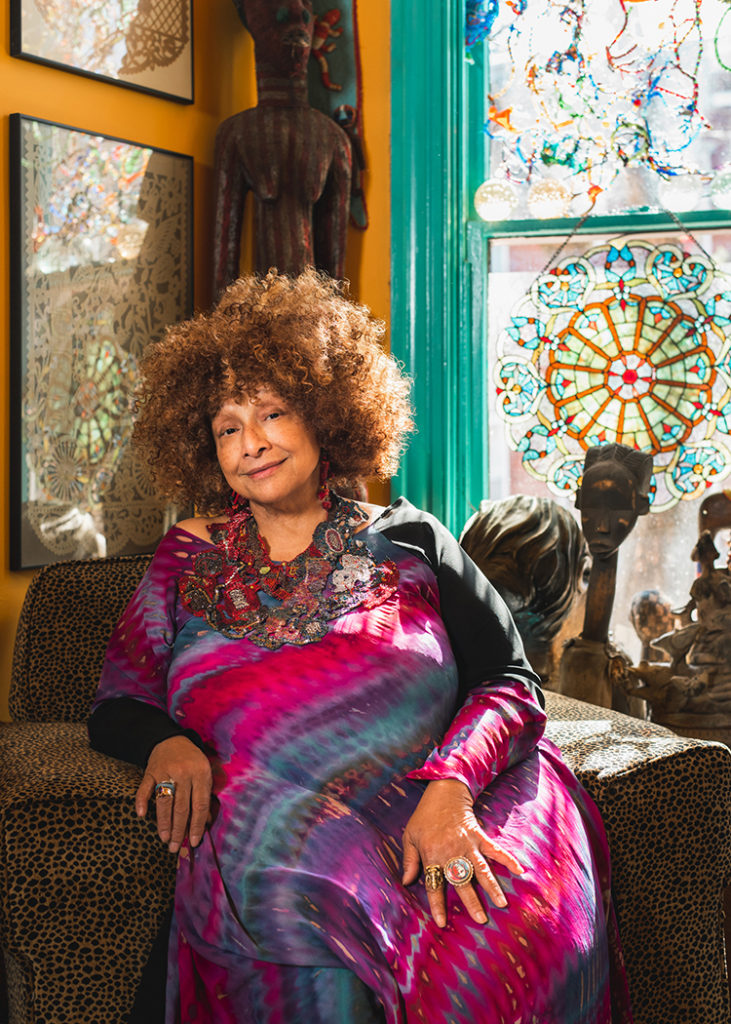
Roots/Routes
The first thing Scott will tell you about herself is that she is an “around the way girl” from Baltimore.
It is the place she has lived for most of her life, apart from her graduate schooling in Mexico and the residencies throughout her career that have taken her all over the world. Her residence in Baltimore is purposeful. It is a place she refuses to leave. As present-day Baltimore is often cited as an area plagued by police brutality, under/unemployment, and crime, Scott believes that her departure would present anything but a solution.
Baltimore is where Scott was born in 1948, but her family’s story, and by extension the ethos of her art practice, is firmly rooted in the Carolinas and a “dense intervention of love and support” of her community.
Her parents, Elizabeth Talford Scott (née Caldwell), a renowned quilter and artist in her own right, and Charlie Scott, Jr., were born into sharecropping families in Blackstock, South Carolina, and Brightleaf, outside Durham, North Carolina, respectively. Sharecropping, or tenant farming, is the agricultural system wherein landowners grant tenants a tract of land to grow cash crops. The farmers usually borrow money for seed, food, tools, and other expenses from the landowner to be paid back from whatever portion of the harvest they receive. In America and elsewhere, this has often proved to be an endless cycle of debt for many families.
“My mother was one of 14 children (12 survived). They were sharecroppers. My mom and her family picked cotton. My grandmother didn’t pick cotton because she was having all those babies. My grandfather worked on the railroad and had a variety of jobs. He was a sharecropper, he was a musician, he used to raise horses, and he was a quiltmaker as well—as well as my mother’s mother,” Scott recalled.
The family would often nestle together and lower the quilting frame from the ceiling to co-create quilts using whatever pieces of fabric they had or were able to buy, swap, or get from the mills where the cotton they grew was processed to keep the family warm at night and during the cooler months.
“People would sit around; the children were under the quilt, making samples, playing, making it a tent. They would send up the needle when they’d go too far and the person sewing couldn’t catch it,” she explained.
Her father, Charlie, whom everyone called “Scotty,” was born into a family of eight. In Brightleaf, the Scotts were sharecroppers focused on vegetable and tobacco crops. His mother, too, was a quilter. In both communities, the children were able to attend school only when they did not have to work on their family’s plot of land. Even in the one-room schoolhouses of the rural South, segregation was enforced. Scott recalled hearing stories of a sheet being used to create a partition between children of different races in the classroom, despite all being from sharecropper families. The white children often used racial epithets and were given the newer books, but they sometimes wrote friendly notes to their Black classmates.
Despite their lack of formal education, for both the Caldwell and Scott families, the commitment to providing better for their families was unshakable. As we talked, she spoke about her family with so much warmth that it was hard to not feel connected to them.
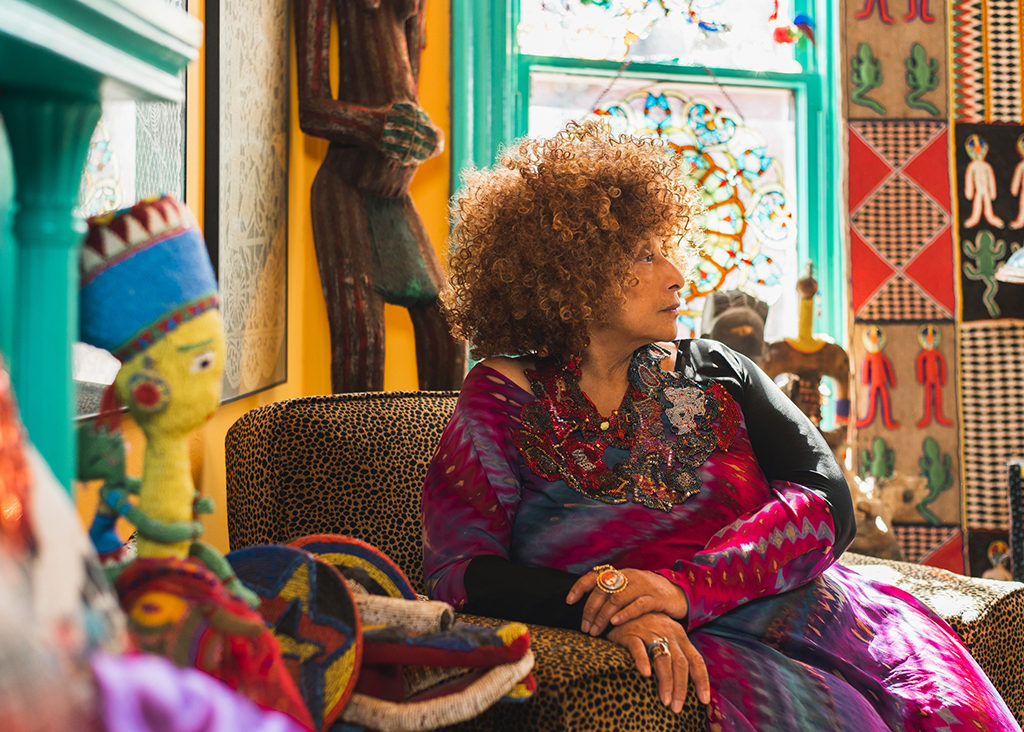
Scott’s parents met in Baltimore during the height of the Great Migration—the exodus of Black Americans from the Deep South to urban centers in the Northeast, Midwest, and West to cities like New York, Philadelphia, Chicago, Detroit, Los Angeles, and Oakland to strive toward what they hoped would be greater opportunity less influenced by racial discrimination.
Her father in particular wanted to be in “a place where you just couldn’t be waylaid on the street on the way home, or pilloried and put into jail, and forced to be on a chain gang, or somebody’s factory worker,” Scott shared. Her mother was following in the footsteps of many of her siblings who had come North in search of employment opportunities.
Scott was born in the Sandtown neighborhood in Baltimore in 1948. She grew up three blocks away from where Freddie Gray was killed while in the custody of the Baltimore Police Department in 2015. The city is the place where centuries of her ancestors’ blood, sweat, tears, and creativity coalesced to make her into an artist unencumbered by any of the limitations and tropes about what a Black woman artist can produce. She recalled her childhood in 1950s Baltimore, when people from every socioeconomic strata lived in the same community. These dynamics bestowed visibility, and, thus, options of different paths possible for young people. Imagine the aspirational power of seeing someone who looks like you achieving something you never imagined you could. Imagine, too, what the absence of that possibility can do—and has done.
Scott began making art with her mother before she could speak. As a toddler, she spent time with family members who were active in the Pentecostal church in Baltimore. Looking back, she traced the roots of her flare for performance to those days in her godparents’ storefront church.
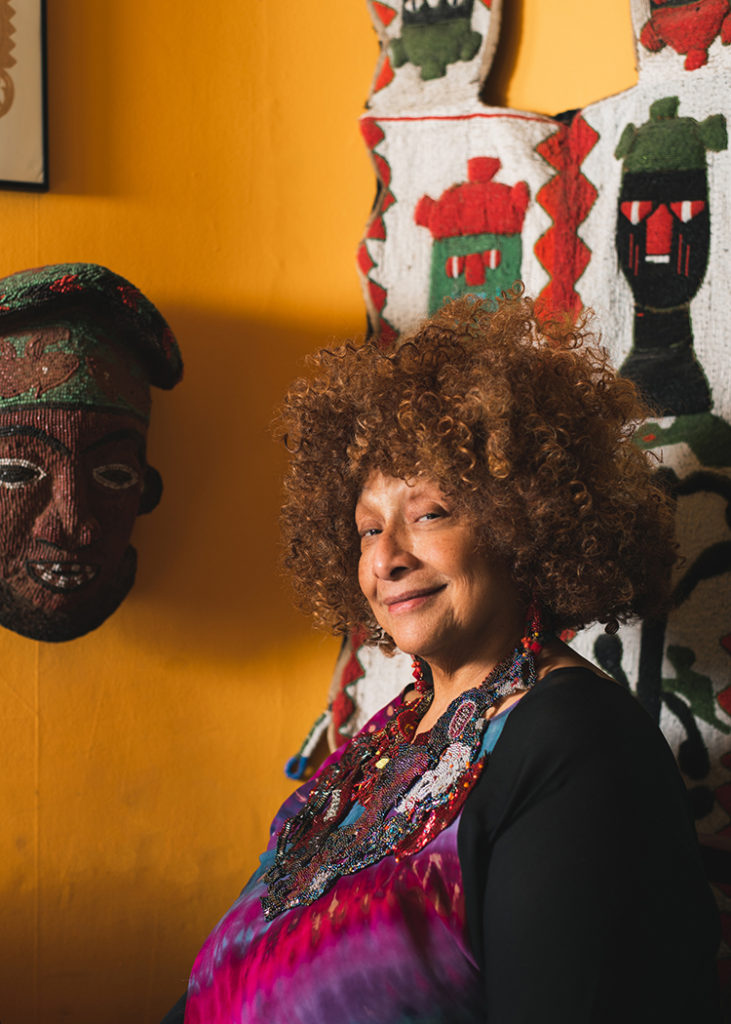
“Both of my parents had to work all the time. When I was very young, I was with my godmother and godfather in the day time (or after school). They were my mother’s niece and her husband: Aunt Lucille and Uncle Wally. They were Pentecostal preachers. When I got obstreperous in the congregation, my Uncle Wally would preach with me in his arms. I believe that’s the beginning of my theatre. I also did street ministry with them. I didn’t remember that. One day when they were older, they would say, ‘Yeah, you used to play the tambourine and you would get us extra money because you were so cute.’”
She remembers the church as a lively environment that would engage the young people to showcase their literacy to the community. For many families, the move North signified their first true opportunity at equitable learning environments. For Scott, it became a training ground of sorts.
“We went to a storefront church… one of those kind of loud churches where people would have the Holy Ghost. You’d have to say a verse from the Bible, and you were always trying to stand up first so you could say, ‘Jesus Saves.’ If you were the last one, you would have to do the longer, complicated verses: ‘My Father’s house has many mansions. If it were not so, I would not have told you so…’ and on and on. There was a lot of being saved in that church. I look back on my godparents, who also did not read and write very well. I think that might be where some of my humor and scatting is from. They would eviscerate words, and I still like that! I don’t think there’s a word better than Deuteronomy—isn’t it like [gasp] ‘Dueteronomy?’ And Ephesians, and they’d call it ‘Efisions.’ I loved that! But at the same time, the older ones couldn’t always do a reading when they were called upon; some had faulty vision, and others couldn’t read well, so the younger ones would do it. This brought pride to the elders to hear their young’uns eloquently read with ease, using a skill denied to them. It was really important for kids to go to school. Their oratory was a testament to the wonder of learning and the blessing received,” she said with a hint of delighted longing.
“We’re really talking not long after Reconstruction. Remember back then, before this kind of technology we have today. Back then, ten years was more like 30 years—it took people forever to evolve into something else. When my mother was born in 1916, I think it was de facto 1890. They were still wearing long dresses. People were really living as indentured servants instead of slaves. And from that period, the first thing people did was build a church with a school in it. School was really important,” Scott explained.
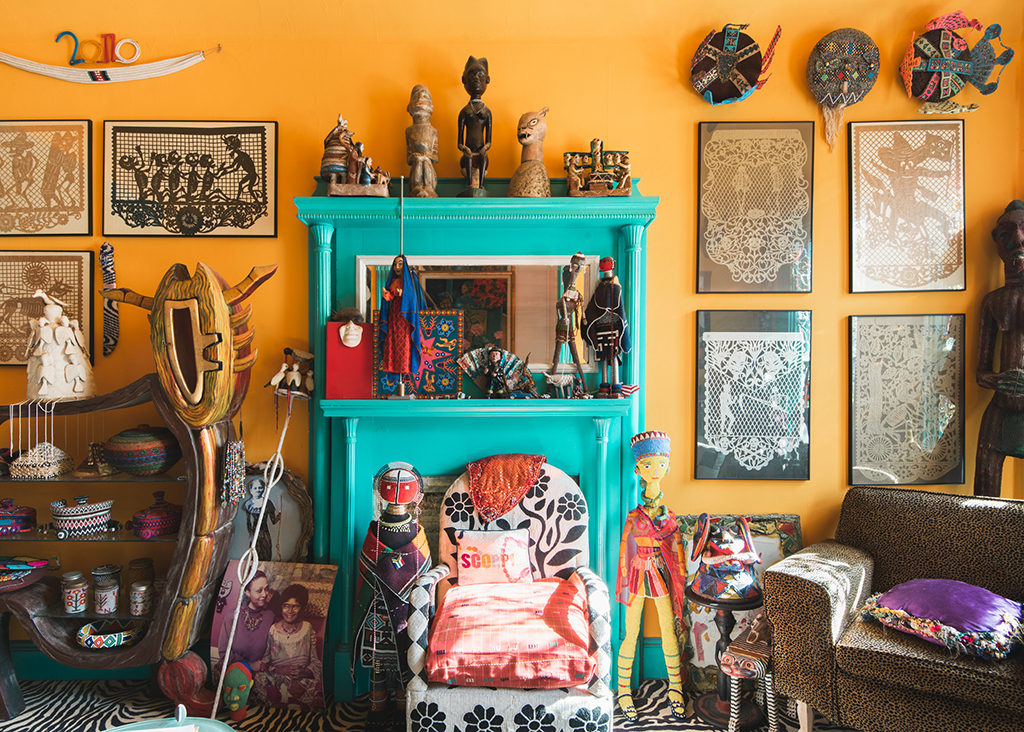
The theatricality nurtured at home and in the pews evolved as the artist grew older. Daily in grade school, she donned her unique and personal couture made out of baubles found around the second-floor walkup where she lived with her mother. Each morning, her mother would wait until after Scott left for school to make her way to work, just in case the principal sent her back home to change.
“I lived a block from my elementary school. The principal was O’Neal Hammond, artist and historian Leslie King-Hammond’s former mother-in-law; her first husband was her son. Most of the time, I could get by her. She stood at the door. She’d get me because I had shit hanging from my head, or a hula hoop tied to my clothing. I was, like, seven. The moms would be looking out of the window at everybody going to school. My mother would wait and call her employer; if I was really adorned, she would say, ‘I may be late, she’s coming back home.’”
School was fertile ground for Scott. During her high school years at Eastern High School, a transformational moment happened. She met educator and painter Olin Yoder. Yoder, practically a legendary figure in arts education in Maryland, was instrumental in making sure Scott was in the right environment in the next phase of her life as an artist.
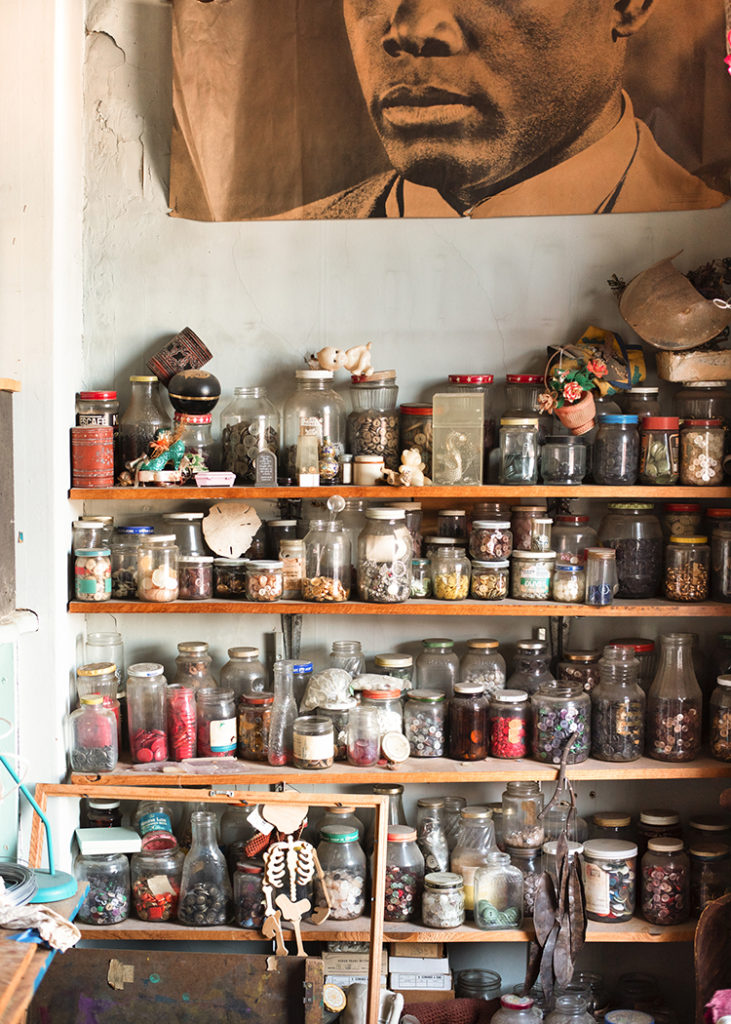
Coming of Age
“I always had very supportive teachers. Olin Yoder helped me get my scholarship to Maryland Institute College of Art (MICA). He had the ability to help students of color get scholarships, and he did it. He was just out of school, so he was maybe only ten years older than me.”
Through Yoder’s recommendation and the merits of her talent, Scott started undergraduate studies at MICA. She thought she would work as a painter, but was quickly disabused of the notion by her instructors. She admits that it was to her betterment. She began to explore other aspects of making that incorporated sculpture, weaving, and beading techniques that she had learned from her mother, and experimented more with literature, poetry, and performance.
During her time at MICA, the shifting social milieu of the city and the country at large was reflected in student affairs. Integration loomed large in the public imaginary and MICA students worked to make it a reality.
“We were always making something. That school being there in the 60s, we had a lot of rebels there. Baltimore at that time was a larger, real working-class community population, because we still had industry—chiefly with Bethlehem Steel operating. If we had another white kid, they were probably just like me—an ‘around the way’ person in their community. You felt that. We really helped to integrate MICA. Dr. Martin Luther King, Jr. was assassinated when I was there. Robert F. Kennedy was assassinated. I was there from 1966 to 1970. My class was the one who started the Black Student Union that is still operating on campus now,” Scott intimated. “When we talk about commitments to the community, not only did I not leave, but I believe you’re supposed to invest in your community.”
Upon receiving her 2016 MacArthur Foundation Award, Scott continued her commitment to giving back by endowing a scholarship for students at MICA.
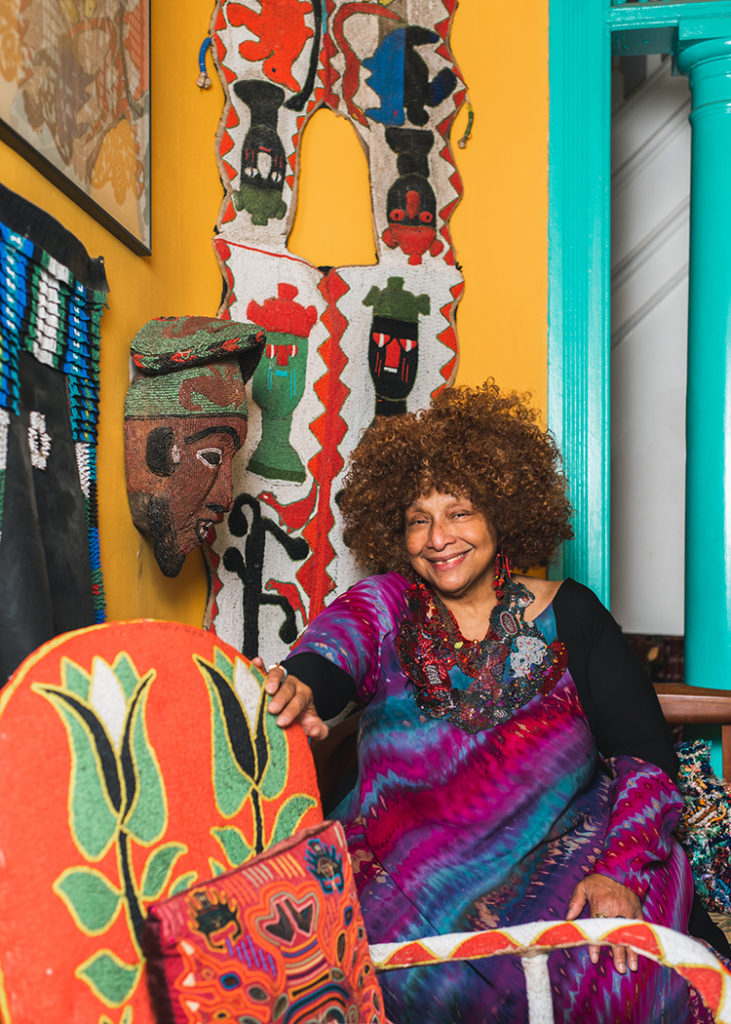
The Art of Adaptation
The heart of Joyce J. Scott’s fiber art practice rests with beading and glass, the forms through which most of us have come to know her work best, but that is not the full extent of her work. Listening to her speak about her childhood, it is clear that this woman is a creative soul who was given the gift of space to explore every aspect of her creativity and gain the knowledge and mastery to bring her ideas forward.
In 1976, during a stint studying at Haystack Mountain School of Crafts in Maine, Scott learned the “peyote stitch” from a fellow student, a Native American woman who was also attending the school. This stitch allowed Scott to weave and bead without a loom. She could make her beadwork in any form she wanted, and this is precisely what she did.
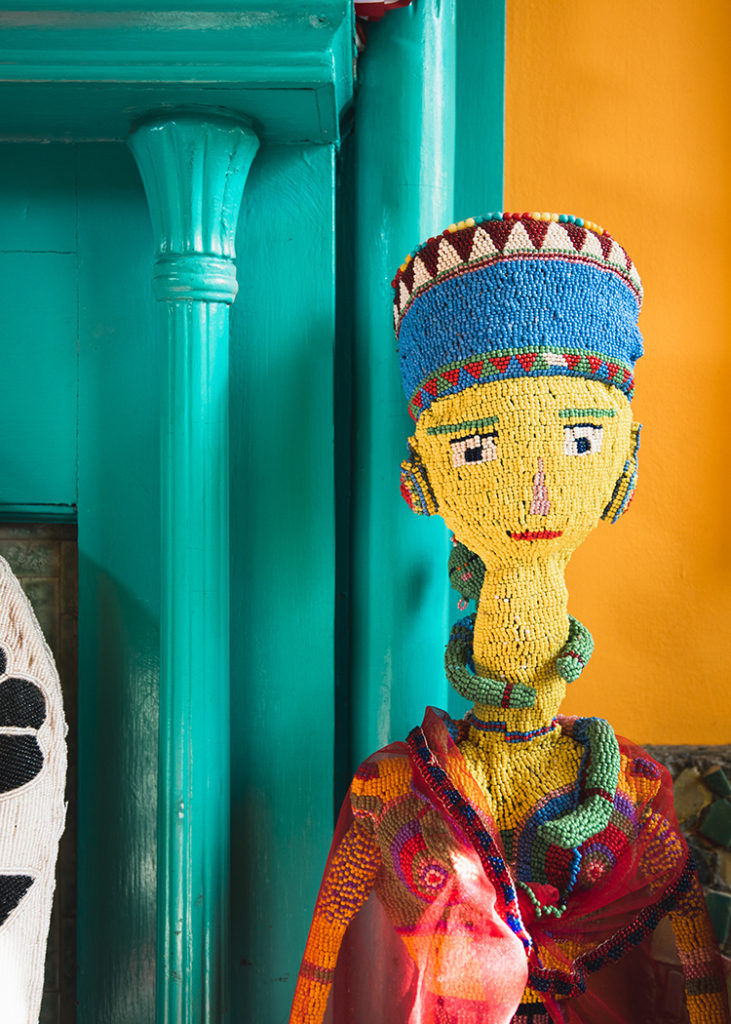
Moving into the 1980s, Scott devoted her time to whatever medium was best suited to what she wanted to express. Among the most well-known is the performance project Thunder Thigh Revue, a two-person comedy and variety show featuring fellow Baltimorean Kay Lawal-Muhammad. The Thunder Thigh Revue was firmly rooted in radical body positivity, lampooning American culture’s judgement of overweight African American women, and other progressive political and social issues. Throughout the 80s, the duo toured the United States, Canada, and Europe. In 2012, they reunited for a short run at the Baltimore Theatre Project.
“Quite honestly, my entire artistic life has been a jumble of different media. For the Thunder Thigh Revue, I was writing, singing, performing, traveling. At the same time, I was in the studio, and doing some writing about that. It’s always been whatever device I had that could best explain my art practice. That’s what I was after. And it didn’t have to be visual,” she explained.
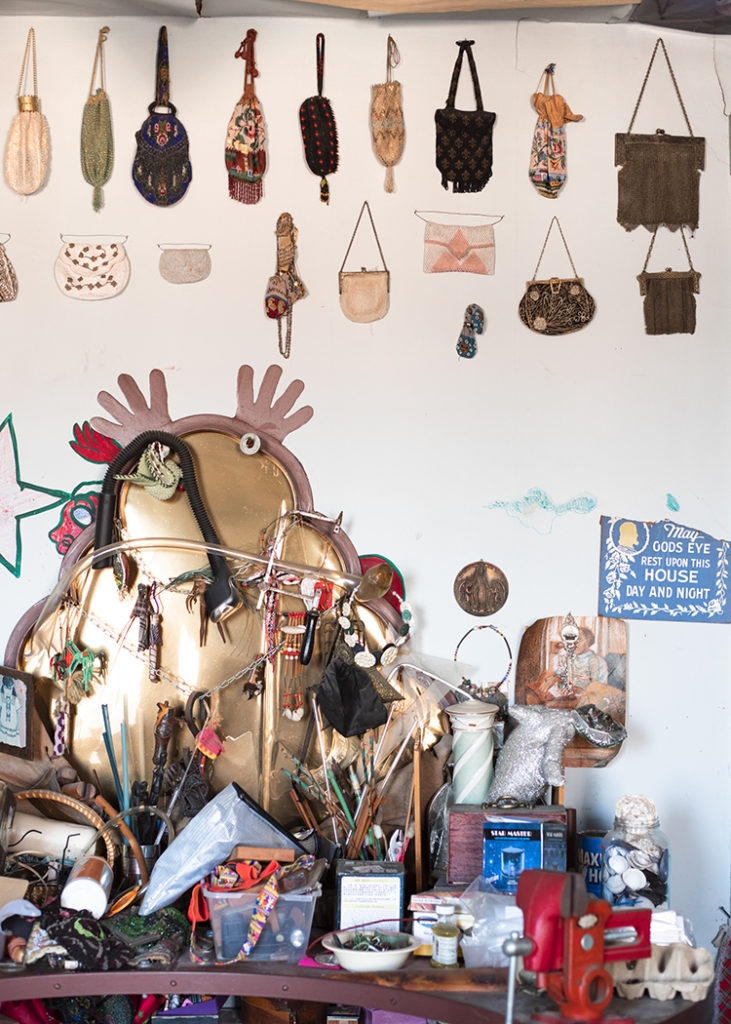
Since the 90s, Scott has worked with composer and performer Lorraine Whittlesey on the collaborative Ebony and Irony, a “subversive cabaret” show featuring original music sometimes centered on race and humor. For decades, the artist’s work has taken shape through social commentary, shining a light on the often overlooked and contentious issues of gender and body politics that most affect our modern global society.
In her fiber and glass work, Scott is concerned with translucency—how light is absorbed or refracted from a surface; how it may make you question what you are seeing if the material can bend the light just right. Her engagement with the medium began first with industrial glass like empty post-consumer pickle jars. Her first foray into working with glass was at Haystack when she returned to teach in the 1980s. Working with pioneering glass artist Fritz Dreisbach, Scott experimented with integrating the glass form into her practice.
“I just knew that glass was going to be a part of what I do. I kept meeting glass artists who were amenable. I don’t blow glass myself, but working this way allows me to collaborate with someone, and takes me out of only one way of doing things,” she explained.
Throughout the 80s and 90s and into the present, Scott has held residencies and created collaborative partnerships with glass artists at institutions that have helped to expand the material aspects of her practice—including Penland School of Craft in North Carolina, Pilchuck Glass School in Washington state, and most recently, the world-renowned Berengo Studio in Venice, Italy. Working with Baltimore glass artists Tim McFadden and Anthony Corradetti, and inspired by other glass artists like Dale Chihuly and Paul J. Stankard, Scott seeks to use the medium for its electricity, energy, and excitement—not unlike her personality. Glass is among the longest standing materials with which humans have worked, and for that reason, she thinks of experimenting with it as “playing with history.” Through working in the medium, she hopes to infuse it with some of herself. By all accounts, she has succeeded.
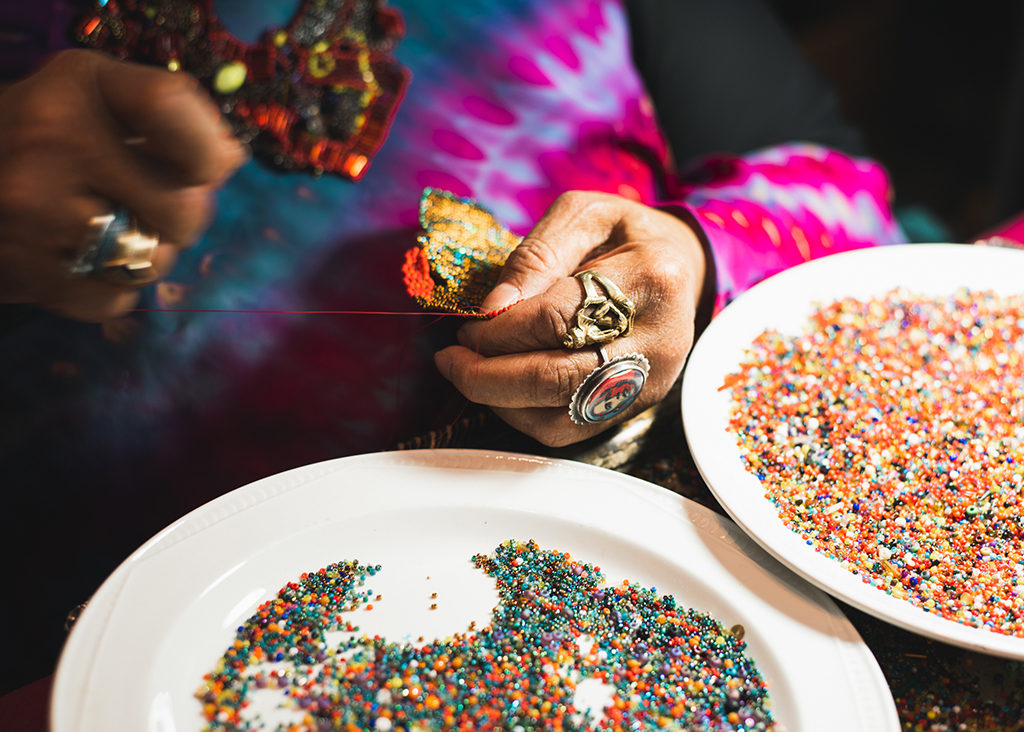
For Scott, beads and glass work like pointillism. They both form and break apart an image. Especially considering the subject matter, this makes them potent tools for her imagery. Scott takes a tongue-in-cheek or outright jarring approach to serious subjects. The works in her Still Funny and Ancestry/Progeny series examine race, sex, history, and their intersections with identity and power, tinged with her sharp, biting sense of humor. Her charged Day After Rape series delves into the global health issue of rape and violence against women; these works often specifically reference human rights violations in Bosnia, Congo, Darfur, and other locales which mirror the horrors of the West. The works are often at a scale that requires a viewer to move closer to the work in order to fully contend with the scene on display. Whatever the medium and subject matter, Scott has a penchant for making her art come alive through an interplay of humor and light. The scale of her beadwork can range from wearable jewelry, to eight-inch sculptures, to eight-foot wall hangings, to her most recent 15-foot sculptures created from earth and grass for Harriet Tubman and Other Truths.
In the first months of this year alone, Scott served as the keynote speaker at the CAA conference in New York and the Firestone Lecturer at Mary Baldwin College. In February, she was named the 2019 Smithsonian Visionary Artist for her “outstanding work in jewelry.” The award is reserved for American artists whose “work represents the pinnacle of sculptural arts and design”—it is truly incredible to have art created by someone whose practice is based on the traditions of Gullah and Native American peoples recognized for its power and beauty.
This summer, we have three opportunities to view her art. In April, the Bergstrom-Mahler Museum of Glass in Wisconsin opened Reflecting Perspectives, a group exhibition that features her work (on view through September 22). Since May, Baltimore has been afire with REALITY, Times two at her gallery Goya Contemporary (on view through July 16), and Hitching Their Dreams to Untamed Stars at the Baltimore Museum of Art (through December 1). Both Baltimore-based exhibitions feature new works by Scott alongside her mother’s textile works.
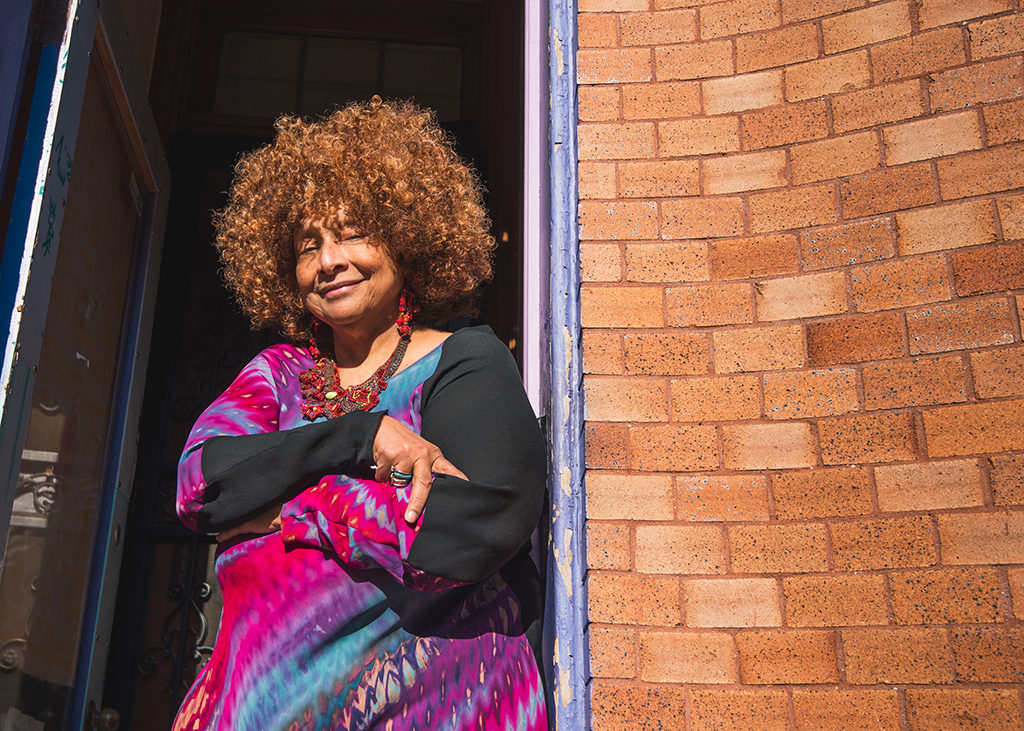
Joyce J. Scott’s genius and grace are legendary. And, finally, the world outside of Baltimore and the communities of collaborators, admirers, curators, and collectors who have championed her work and pedagogy for the last four decades have caught on to the artist’s staggering talent and work ethic. I have no doubt that the coming years will prove to be as prodigious for Scott as ever, and I cannot wait to see what wondrous works arise next.
Niama Safia Sandy is a New York-based cultural anthropologist, curator, and essayist.
Sandy’s work delves into the human story—through the application and critical lenses of culture, healing, history, migration, music, race, and ritual. Her creative practice is often an examination of the ways history, economics, migration, and other social forces and constructs have shaped modern realities. Sandy’s aim is to use the visual, written, and performative arts to tell stories we know in ways we have not yet thought to tell them and to lift us all to a higher state of ontological and spiritual wholeness in the process. She is an alumnae of Howard University, SOAS, University of London, and the No Longer Empty Curatorial Lab.
Christina Hicks is a self-taught photographer, creating editorial and commercial imagery for clients in the fields of design, fashion, travel, architecture, and technology. Her work is informed by a continued interest in sustainability in all typologies and scales, inspired by her design background in landscape architecture and urban design.
